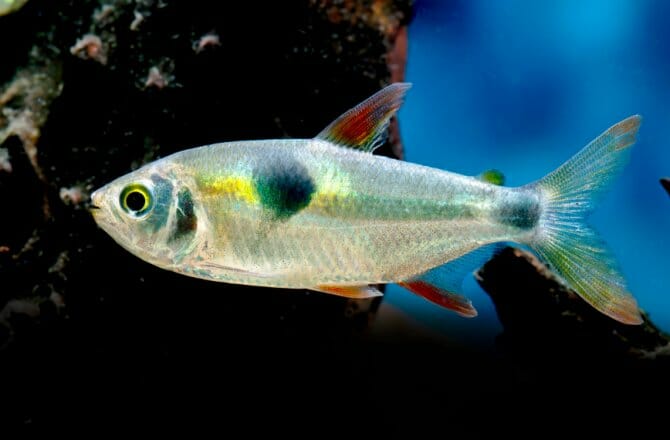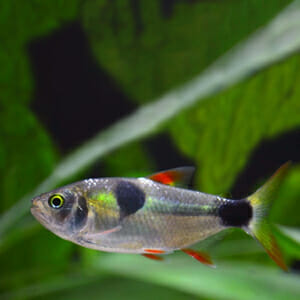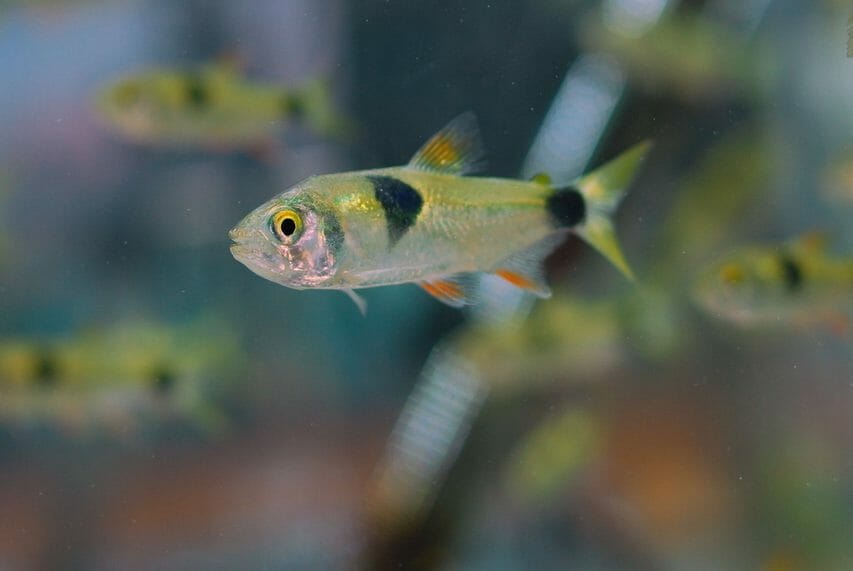Bucktooth Tetra | A to Z Guide – Care, Tank Mates, Size and Diet

Table of Contents
Overview/Origin
Do you like small, fancy-looking fishes for your aquarium? Tetras, for example, are widely known to have very amiable temperaments and are perfect for any community tank. But did you know that this does not stand true to all their types?
The Bucktooth tetra, for one, is a small but relatively aggressive fish for the tank. Their instinct to prey over other fishes might not even make it easy for you to look down for a good tank mate for them!
The fish first prevailed in the Tocantins rivers of Brazil and Rio Branco in Guyana. The tropical climates in these areas provided a water habitat that even houses other fishes with carnivorous nature, such as the piranha.
Distributed to the other neighboring countries and the rest of the world, they are now given the label as a Premium Pet Fish for being produced from commercial methods.
Appearance
The signature look of tetra fishes is apparent in the bucktooth tetras. The uncanny difference in appearance would only be in the large spots on the sides of the fish and in the base of their tails.
Their silver bodies are adorned with glimmers of yellow or orange, sometimes also reds. With these color accents, the fish glow beautifully while swimming under the light!
They are small and their shape is close to that of any tetra fish you have seen before. Their fins are light-colored, mostly yellow, and adds to the jolly and active appearance of their look!
You might think that their name comes from some protruding front tooth they own, but this is not totally true. The bucktooth tetra only had uniquely pointed teeth, but they are strong enough to tackle the scales of the other fishes! They can do this from minimal to no effort at all, making them an adversary around other peaceful tank fishes.
Behaviour & Temperament
The bucktooth tetra is known to be a volatile and hostile fish species in the fish trade. It would not be easy to pair with any species as they get easily aggressive and are always ready to gnaw the other fish’s scales.
Despite their abrasive manner towards other fishes and even to their kind, the bucktooth tetras are still a joy to have in any aquarium! Unlike the other common tetras that are rather shy and docile in character, the bucktooth tetra is more active and loves to move around the tank!
When in groups they are very eye-pleasing to watch too as they move in shiny, silvery colors. If you like having a tank with a high level of activity from small fishes, then put the bucktooth tetras at the top of your list!
Lifespan

How long does Bucktooth Tetra live?
Perhaps, you wonder if the bucktooth tetra is one of those small fishes worth your money spending. If you decide to keep the bucktooth tetra for your aquarium, then the great news is they are indeed worth the try!
In their natural habitat, these tetras can surprisingly survive for a max of 10 years. You may call it a small but uniquely hardy fish, for that matter. Being carnivorous can also be the reason why they have such a long-living capacity.
They consume more meat, and that means protein! This food element has an essential part in the survival rates of the bucktooth tetra.
Even in captivity, the fish can still have a long lifespan, as long as the owner does not miss any essential thing that the fish needs for its habitat. For most fish owners, the bucktooth can even live more than five years if they are inside tanks. You can also imitate their original environment and this is very ideal for them in the long run!
Common Diseases
No species-related disease can be worried about bucktooth tetras. Instead, they can only be affected with the same kind of ailments that other aquarium fishes may also get.
You still had to look at the possibilities of them getting bouts for bacteria or parasitic infections. One common disease that the owner might encounter is the ich. Ich is a fatal illness that causes itchy white spots in the body of the fish. The disease slows down the movement of the infected body and can be risky to keep long in a tank full of other fishes!
Other fish diseases that you need to be aware of are fin rot and fish fungi that are truly deadly when left unattended. Most of the time, fin rot is the decay of fish fins due to undesirable water conditions.
These diseases can all be avoided from the very beginning if you are to give extra attention to the water. If there is no tank maintenance, the water may manifest parasites that could endanger your fish. That is why water replacement is very much advisable to be done as frequently as every week.
Ammonium build-up adds to the spoilage of water. It can contribute to ailing the fish and can only be eliminated if proper care and attention of the biome is clean in the first place.
Diet also plays a crucial part in their body defense against ailing conditions. Serving them food enriched in vitamins can impact them with a healthier immune system.
Size

How big do Bucktooth Tetra get?
The fish has varying sizes ranging from 1-5” the most. For small ones, the Bucktooth Tetra can reach up to 3.5 inches in their adult forms. Some reports even say that there are a few that can also grow to at least 6 inches once they reach maturity!.
Their growth is also affected by the food they eat. If given foods that have high nutritional value, the chances are they are not only going to grow well in height but also get to have round and sturdy bodies!
How many Bucktooth Tetra can be kept together?
As not compatible with community tank fishes, the bucktooth tetra is best around their same kind. And keeping a lot of them in the same tank is better than having them in a few numbers.
You should be able to manage at least 10-12 bucktooth plecos for a typical tank. Lesser than this number might cause competition on the tetras. And worse, even attack each other for dominance.
Obtaining a larger tank for the fish is very beneficial for them too. Allowing your bucktooth tetra fishes their own spaces will cut conflicts inside the tank, no matter if they are so many inside.
Bucktooth Tetra Care

Tank Size
Focus on buying larger tanks over regular ones, as the fish were quite territorial and aggressive against other fishes. The tank to prepare should also be roomy enough for a dozen bucktooth tetras, at least. Fifty-five gallons is the adequate water capacity that the aquarium must handle.
Remember that the bucktooth tetras are active swimmers, and the bigger the area they can roam in, the lesser is their aggressive behavior to show.
Take note that keeping them in numbers reduces their tendency to attack or salvage anything they see wiggling on sight. This kind of tetra is also a shoaling species, and so a bigger tank can cater to their group better.
Tank Setup
It is fun to create a diverse background for the bucktooth tetra. Take note only that you don’t have to overcrowd the tank with plants and decorations, as the fish is too active in roaming and doing lively swimming in the light.
They are most likely to be showy in the middle and upper areas of the water, and may not even dwell much in the leaves around them.
Still, you may add beautiful water plants such as the Java fern and other floating plants to increase the aquatic ambiance! Driftwoods and caves can be well-shaded places to create dim areas in the tank too.
The tank substrate must consist of dark sand like in the places where the fish originated from. Sand is where the tetra would proceed most of the time to look for food, and the material can even aid in their digestion!
Lastly, to aid you in keeping the water clean all the time, and also in water replacement schedules, it’s great if you install a quality canister filter for the tank.
Water conditions
Luckily, the bucktooth tetras do not need strict procedures in setting up the water they need to live in. The fish have the same standard water environment as those fishes who live in South American tropical places.
The following are the basic guidelines for you to follow, in case you had to set up one:
- Water pH level: The place of origin of the bucktooth tetras is slightly acidic due to decaying leaves that fall and run through the river beds. Hit up a level of 5.5 to 7.5 pH to maintain the acidity level on the tetra’s tank.
- Water hardness: With hardy bodies, the bucktooth tetras still need to be used in a standard of 0-15 kH of water hardness.
- Water Temperature: Like the warm climates of South America and Guyana, let the tank water have a range of 72°F to 82°F for the fish to live in. The average of 75 degrees is even ideal to be adjusted consistently for them all the time.
Diet & Feeding

What do Bucktooth Tetra eat?
Carnivorous as they always are, bucktooth tetras’ main diet in the wild are protein-rich foods and fish scales! Their tummies are always filled with digested scales. That is why many owners would try to serve more live feeder fish to them as part of their daily diet.
The piranha-like fish would be satisfied with the food that contains meat, and so they will not reject simple fish foods such as brine shrimps or bloodworms.
You may also include insects and larvae in their meals and from time to time to vary their food intake.
Meeting their nutritional needs is also necessary and so if you want them to not tackle their fellow fishes in the tank, making sure that they have their own fill every mealtime will make them less aggressive too!
How often should I feed my Bucktooth Tetra?
Fishes that eat meat-based foods may feel full for hours and are even said to live longer than herbivore fishes. You can feed the bucktooth tetra within schedules of two to three times a day.
Giving them substantial portions of protein can make them not look for food frequently. Having this done can even save your time!
Bucktooth tetras also are not fazed with the plenty of edible plants they might get surrounded in, so if you are to leave them for a while, note that they might instead look for the weakest fish in the tank and see it instead as their food target.
The good thing is that they can benefit from eating live feeder fish placed in the tank before you leave them. Still, they may eat from an automatic feeder but be wary that they may not always prefer being given flakes and pellets as alternatives for their craved foods.
How long can Bucktooth Tetra go without food?
Like any typical aquarium fish, it is safe to say that the predatory tetra can strive with no food for three days to one week.
They may not always be easy to get hungry, but for sure, the bucktooth tetras love snacking on scales of other fishes all the time! As one of the ferocious tank fishes out there, they are also not picky with food presented to them.
And so, if you are to leave them for days or more, trying an automatic feeder might be helpful in the long run. If not, placing plenty of alive, small, and scaly fishes for their eating would always be an excellent option.
Tank Mates
What fish can live with Bucktooth Tetra?
Many aquarists would agree that an aquarium is supposed to have many types of fish and not only one species. But with the predatory fish here, that might not always be the case.
The bucktooth tetra is always called off as an exemption for community tank fishes. Its nature to pick off other fish’s scales are feral no matter the size and body mass that prey fish have. Well, they are even more savage and efficient than the piranhas!
With this in mind, it is not surprising that no particular tank fish can serve long enough on the same abode with these tetras. You may think about cichlids, but these fishes cannot stand a chance of longevity in the bucktooth tetra’s tank. Stress from such an environment can even contribute to their early death, too.
Still, if you want the tetra fish to have company, you can always multiply their number in the same tank. They are not as aggressive to each other when there are so many of them.
What fish don’t do well with Bucktooth Tetra?
Being the most aggressive tetra, the bucktooth one is not compatible with most aquarium fishes in the trade. First off, they are not to be combined in the same tank where calm and slow-moving fishes live. The tetra is too active and swift in attacking anything interesting to it.
Some of these fishes are the neon tetras, cardinal tetras, guppies, rasboras, catfishes, gouramis, and most freshwater and tropical fishes. If you have any of these small ones, it is best to relocate them to a better tank space.
To say that the bucktooth tetra is a scale-eater, take it that they would also annoy other large, or aggressive kinds of fishes. Fishes like the rainbow sharks, barbs, cichlids,and angelfish are not advisable to be kept around them.
Breeding
With the temperamental behavior of bucktooth fishes, it is understandable that they also have low ability to rear an offspring. But, breeding them is still possible despite the challenging nature of the would-be parent fish.
Though they are rarely bred by most owners, the eggs that will be produced can be secured well away from the preying adults. Try to set up a different tank for this breeding procedure.
The bucktooth tetra would easily drop their eggs at the bottom of the tank. But placing a mesh or a layer of low-lying plants will protect the eggs after successful spawning. Always bear in mind that these eggs must be separated immediately from the parents to prevent these from getting eaten.
Begin the breeding process, by at least preparing first the pair of adult tetras in exclusive high-protein feeding. Next, the tank water that they are to be placed in must also be adjusted in warm temperatures. The water can be taken from the main tank with half part of it replaced with clean. The water condition must still be apt for the incoming young tetras to adapt in.
Once the spawning is done, it is important to return the adult pair/s to the main tank. The eggs will hatch in a matter of two to three days.
Note: Not all eggs will be able to survive to grow. Once hatched, each fry will display their aggressive nature and might even try to pick and attack on one another. Prevent their numbers from dwindling by always providing them food to eat (e.g., brine shrimp).
Summary
Are Bucktooth Tetra easy to care for?
Anyone that has some experience in fishkeeping will be able to handle the combative bucktooth tetras. The fish may have not-so-appealing characteristics compared to other personable fish species. But sure, they are still a source of aesthetic beauty and activity in any owner’s tank!
Keeping these tetras could be challenging for the beginners, too. But, with a bit of know-how and planning beforehand you will also be able to manage them well. Indeed, many owners are successfully growing them for years!